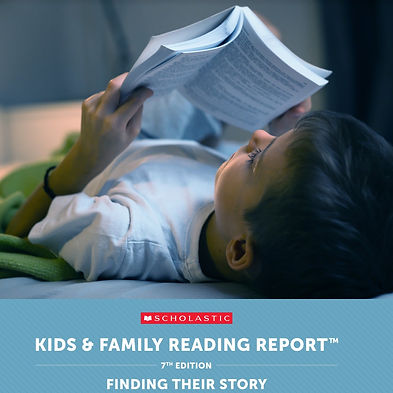top of page

WHAT THE RESEARCH SAYS
Classroom libraries are critically important, as across all ages the data show that kids who have robust classroom libraries are more likely to be frequent readers.
Key findings of Scholastic's Kids & Family Reading Report 2017: Finding Their Story
"Reading for fun spurs the imagination and encourages kids to develop their own thoughts and ask questions. Different books can also help them to learn different thing they might not seek out themselves." - a parent of a twelve year old.
Other key findings include:
Reading to Navigate the World
1) School-aged child's relationship with reading have remained fairly steady since 2010 in the following areas.
-
58% say they love or like reading books for fun
-
52% agree books for fun is extremely or very important
-
31% read books for fun 5 - 7 days a week (frequent readers), 41% read for fun 1 - 4 days a week (moderately frequent readers), 28% read for fun less than 1 day a week (infrequent readers)
2) Yet incremental changes in reading frequency since 2010 have culminated in a decrease of frequent readers (down 6 points) and an increase of infrequent readers (up seven points). With no exception, there is a striking downward trend as children grow up. By age nine all three critical measures noted above decreases dramatically and rarely rebound as kids move through adolescence.
3) Loss of engagement means kids miss out on the benefits books provide - agreed by both kids and parents.
-
74% of kids and 88% of the parents say that reading fiction and non-fiction is a way to help them understand the world
-
53% of kids and 55% of parents agree books has helped them/their child through difficult time
-
73% of kids say that reading about current events make it easier to talk about or understand them
4) In the past two years, both kids and parents are less likely to say that when picking a book to read for fun, the type of book doesn't matter.
-
More kids want books that make them laugh, help them explore new worlds and become familiar with new topics
-
More parents want these types of books, as well as those which help their child learn about the lives of others and books that make their child think and feel
Books and Characters to Reflect Our Diverse World
1) About half of kids ages 9 - 17 and parents with kids ages 6 - 17 agree "I wish there were more books available that include diversity"; among those that agree diversity in children's books is important, these percentages rise to 76% of kids and 69% of parents. Black and Hispanic families overall have the strongest views on the importance of and need for books with diversity.
2) Both kids ages 12 - 17 and parents with kids ages 6 -17 are more likely today than they were in 2016 to want books with diverse storylines, characters or settings.
3) Both kids and parents look for characters in children's books that can play powerful role models in young reader's life.
-
The top three most wanted types of characters among kids are those who can be role models, who face challenges and overcome them and those who are "similar to me"
-
95% of parents agree that characters in books can help foster the qualities they value for their children
Access Matters: Reading Role Models and Books
1) Creating literacy-rich environment for children by surrounding them with books and encouraging reading role models (of all ages and types of relationships) makes a difference. Frequent readers:
-
Get more encouragement to read from family members, friends, principals, teachers and school librarians than infrequent readers
-
Are far more likely to say that nearly everyone or a lot of people in their lives enjoy reading
-
Are more likely to have parents who value reading and who read frequently
-
Have, on average, 139 children's books at home vs. the 74 books infrequent readers have at home
2) When kids get to choose, they read. Across demographics, the majority of kids (89%) agree their favorite books are the ones that they have picked out themselves.
bottom of page






